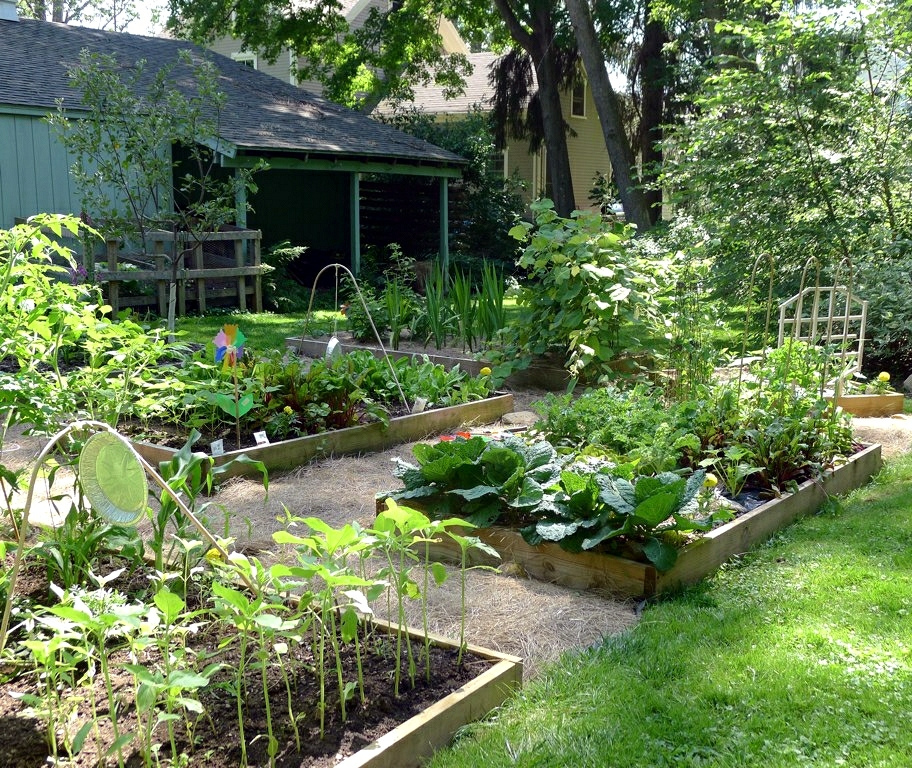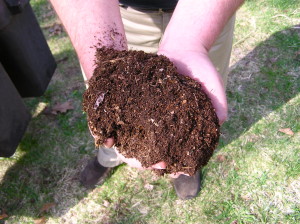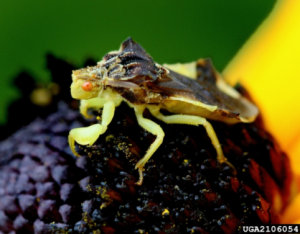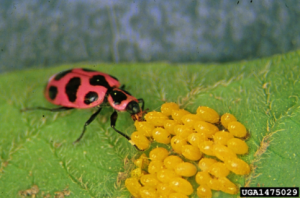
Photo by Lori L. Stalteri
By Aimee Colf, Horticulture Agent, Anson Cooperative Extension
The definition of acceptable “organic” methods may vary greatly between gardeners because no standard definition exists for organic gardening at the homeowner level. Meanwhile, commercial growers must complete an organic certification process and adhere to National Organic Standards. These growers rely on the Organic Materials Review Institute (OMRI) which determines products approved for use on certified organic operations. Compared to conventional gardening, organic options for insect pest, disease, and weed management are fewer in number.
Organic gardening involves practices aimed at building soil health and plant nutrition.
In this article we will address creating a healthy environment for soil microbes, types of organic fertilizers, and specifically, insect pest management.
Soil Microbes
Soil microbe abundance and microbial activity are, in general, proportional to the amount of organic matter in the top 12 inches of soil. Organic plant matter feeds bacteria, fungi, protozoa, nematodes, earthworms, other soil microbes, and invertebrates, resulting in humus. These soil organisms convert fixed compounds into products and nutrients available for plant uptake. This biological system creates a thriving soil community while creating good soil structure, promoting water infiltration, drainage, soil aeration, and vigorous root growth. Mucilage and gummy complex sugars, produced by soil microbes, help bind soil particles together into aggregates which build soil structure.

Research indicates that the ideal growing medium for plants is 35- 50% air space. There are many organic and inorganic materials and practices that can be used to increase pore space, or improve water holding capacity. Soils can be made looser and more friable by double digging, or creating raised beds. Double digging small gardens loosens two layers of soil, about 24 inches down, to make conditions more favorable for plant growth.
Consider incorporating 25-50% organic amendment per volume of native soil. Common organic amendments include the following composted materials: kitchen scraps, manure, sawdust, wood chips, yard waste, or vermicompost. To amend a soil to 50% organic material per volume, spread 2 inches of an organic amendment over the soil and work down 8 inches. Then, apply a second 2 inches of compost, and work that in. This is also a perfect time to incorporate lime or pre-plant fertilizers. These organic additions automatically build temporary raised beds. Shape rows with a bow rake to help shed excess precipitation. As materials break down and the soil begins to level out, add additional amendments to maintain the benefits.
Soil test results can provide baseline data on pH, nutrient needs, and percent humic matter. In mineral soils or soils that have poor tilth, the addition of organic matter will loosen soil, increase air space, and promote water infiltration. The addition of organic matter also improves soil buffering capacity, or the ability to withstand pH fluctuations. This explains why rich organic soils or clay soils require more lime in order to change the pH, compared to sandy soils.
Fertilizers
Fertilizer recommendations are the other part of your soil test results, often recommending various amounts of nitrogen, phosphorus, and potassium to feed soil and plants. Since nutrient composition of animal manures and composts can vary widely, it is prudent to submit a waste sample through your local Extension office before use. Some common organic sources are listed below:
- Nitrogen – cotton gin trash, fish powder, feather meal, fur, hair, hoof and horn meal, fish meal, dried blood meal, corn gluten meal, soybean meal, alfalfa meal
- Phosphorus – bone meal, ash, cotton gin trash, colloidial phosphate, cotton seed meal, leaf mold, fish meal, poultry manure
- Potassium – cotton gin trash, wood ash, plant/animal ash, langbeinite
The addition of organic material, fertility amendments, and green manures can lead to increased soil microbial activity and humic matter content compared to synthetic fertilizers. This impacts soils chemically as well. Cation exchange capacity is increased. Cations are positively charged ions such as calcium, magnesium, and potassium. Organic and alternative amendments increase the negative charge in soils and the capacity to attract and retain cations on soil particles. Overall these inputs can result in greater enhancement of soil biological, chemical, and physical characteristics, resulting in greater soil quality and disease suppression over time.
Pest Management
In addition to soil health, organic amendments, and fertilizers, pest management presents another challenge to organic gardeners. While effective, organic pesticides are minimally toxic to the environment and non-target organisms. The important thing is to be able to positively identify pests versus beneficials and monitor both populations regularly so that, if needed, pest management strategies can be started before they reach devastating levels.
Sometimes the insect can be caught in the act making identification easy, other times you are left with only visual signs of damage which require more detective work. It helps to know the life cycle of insects so that various stages can be identified. Unfamiliar pest specimens can be brought to your local county extension agent for identification.
If a pest problem has reached an action threshold in the garden and landscape it may indicate sub-optimal growing conditions, or possibly an ecological imbalance. Organic pest management places an emphasis on biodiversity and optimal growing conditions to build the garden’s natural resistance to pests. Rather than directly treating a pest, a gardener’s pest management strategy may instead focus on conservation or habitat enhancement to attract more beneficials into feeding and breeding in the problem area.

Ambush bug (Phymata sp.), a beneficial insect often found on flowers. Source: David Cappaert, Bugwood.org
One tip is to take note of the insect pests you have struggled with in the past and concentrate on strategies to manage those. But also be aware of recent climatic conditions. For example, Colorado potato beetles may be more numerous after a mild winter. Unusually wet springs favor slugs, and dry summers favor spider mites.
5 Steps to a Pest Management Program:
- Monitor – Scout your garden often. Examine the trunk, stem, and underside of leaves. Look for symptoms (like chewed leaves) and signs (egg masses) of both pest and beneficial insects in the garden.
- Identify – Correct plant identification is essential. Identify the host plant and learn what characteristics are normal throughout the season and stage of growth. Become familiar diagnosing abiotic symptoms, versus pest or disease symptoms in order to choose the proper corrective action. Similarly, learn to identify insects in their various life stages. Recognize the signs they leave behind and the patterns of damage they cause.
- Evaluate – Determine if the pest has reached the action threshold. What is the level of damage? Is the insect population growing? Are insect pests spreading to neighboring plants? Have you noticed the presence of any beneficial insects (lacewing larvae or ladybird beetles)? Will the plant recover on its own? Is there a better location where the plant will not be as susceptible? Once you know the extent of the problem, make the appropriate management decision.
- Implement – Often multiple methods of intervention must be employed. This is called integrated pest management. It is easier to intervene while pest levels are still low. It is also easier to manage the immature stage of insects rather than larger mature ones.
- Evaluate – What were the results? Remember, it is not necessary to eradicate every individual insect pest. The goal should be to manage them to an acceptable level in which the plant will be able to recover or damage kept to an acceptable level.

Spotted lady beetle (Coleomegilla maculate) feeding on eggs of Colorado Potato beetle. Source: Whitney Cranshaw, Colorado State University, Bugwood.org
The integration of cultural, biological, physical, and/or chemical management strategies can help prevent many problems from becoming serious enough to affect plants or yields. Below is a brief description of each:
- Cultural controls emphasize plant health and are inexpensive measures to prevent infestations. This includes choosing well-adapted cultivars with insect and disease resistance, choosing proper planting location, time plantings during the weak point of a pest’s life cycle, and practicing good garden sanitation. Others include managing soil fertility, cultivating weeds, and mulching to reduce pests.
- Biological controls blend natural defenses into your management plan. One example is parasitic wasps seeking host insects for larval development. It is possible to enhance the habitat for beneficial insects so they do much of the pest management for you. Learn more about the beneficial insect you want to attract, the plants they prefer, and their life cycle needs as they emerge and scout for prey. Be aware that microbial sprays can also negatively affect some beneficial insects.
- Physical barriers are available to protect plants. They start with the basic hand-picking, water sprays, floating row covers, tree bands, cut worm collars, light traps, and pheromone traps. Diatomaceous earth, copper strips, tanglefoot barriers, wrapping fruit in paper bags, and covering in kaolin clay are other types of physical barriers. Pheromone traps are not effective at significantly reducing larval populations but may be helpful in monitoring movements of adults. Be sure to place pheromone traps in locations away from areas to protect, rather than drawing pests into the garden.
- Some organic insect controls are chemical (botanical, inorganic, microbial, and petroleum-based). Chemical controls can be integrated into a management plan if garden pests are out of balance and overwhelming other management options. There are a few synthetic pesticides, like some horticultural oils, OMRI approved for organic pest management. However, it is important to remember that pesticides, organic or synthetic, are still toxins designed to kill pests, and should be treated as such.
No matter your level of organic adoption, or if you choose to do some combination of conventional and organic, your garden will see benefits from actions to improve soil health and tilth, attention to fertilizer requirements/amendments, and improved abilities to identify the different life stages of pests and beneficials, as well as knowing what, if any, actions to take.


